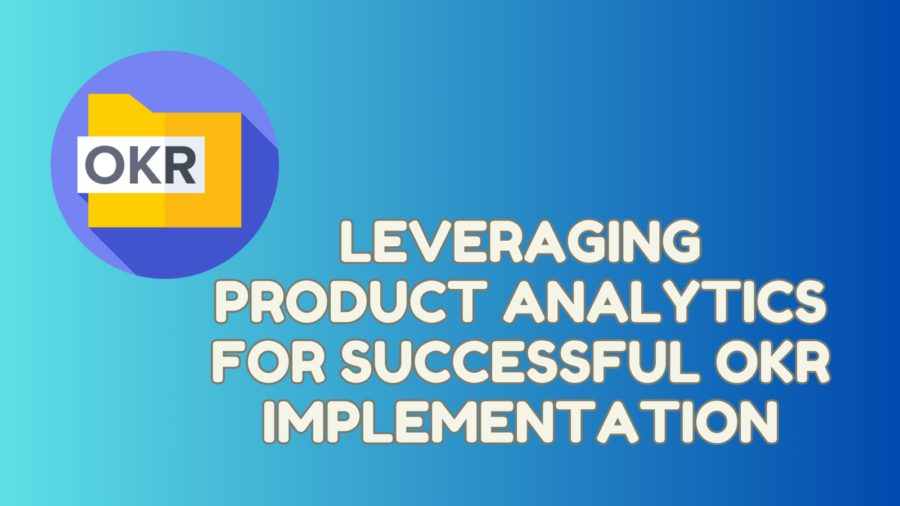Organizations continually seek effective frameworks to align their teams and drive strategic growth. Objectives and Key Results (OKRs) have emerged as a popular goal-setting methodology, providing a clear path for companies to articulate their objectives and measure their progress. However, the successful execution of OKRs requires more than goal-setting; it demands a robust tracking and analysis system. This is where Product Analytics plays a pivotal role, offering valuable insights to support and enhance the OKR process.
Understanding the Essence of OKRs
Before delving into the symbiotic relationship between Product Analytics and OKRs, let’s briefly revisit the core principles of OKRs. OKRs are a goal-setting framework designed to align individuals, teams, and organizations toward a common purpose. Objectives are ambitious, qualitative goals that set a clear direction, while Key Results are specific, measurable outcomes that define success in achieving those objectives. OKRs provide a roadmap for organizations to navigate toward success, fostering focus, alignment, and transparency.
The Role of Product Analytics in OKR Implementation
Data-Driven Decision-Making
One of the fundamental principles of OKRs is the importance of measurable outcomes. For example, to increase user engagement, a company like Netflix can use Product Analytics to analyze viewer habits, content preferences, and viewing patterns. By understanding what drives user engagement, Netflix can tailor its content strategy to meet specific Key Results, such as increasing the average time users spend on the platform.
Aligning Product Development with Objectives: Product Analytics allows organizations to align their product development efforts with OKRs. Take Airbnb, for instance. If their objective is to enhance the user experience and the Key Result involves increasing the number of bookings, Product Analytics can help analyze user interactions on the platform. By tracking user behavior, feature adoption, and feedback, Airbnb can optimize its platform to ensure a seamless experience, directly contributing to achieving its objectives.
Iterative Improvement through Continuous Monitoring: The iterative nature of OKRs demands continuous monitoring and adjustments. Amazon, known for its customer-centric approach, uses Product Analytics extensively. To increase customer satisfaction, Amazon employs analytics tools to track user feedback, delivery times, and product reviews. This ongoing monitoring enables Amazon to make real-time adjustments to its processes, ensuring they stay aligned with their objectives and maintain high customer satisfaction.
User-Centric Approach to OKRs
With its objective of becoming the go-to music streaming service, Spotify exemplifies a user-centric approach to OKRs. Product Analytics helps Spotify understand user preferences, playlist creation patterns, and listening habits. By incorporating these insights into their OKRs, Spotify can set objectives that resonate with users, driving engagement and loyalty.
Practical Applications of Product Analytics in OKR Implementation
Conversion Rate Optimization (CRO): eCommerce giant Shopify leverages Product Analytics for CRO. To increase merchant sales and a corresponding Key Result tied to conversion rates, Shopify uses analytics to identify friction points in the user journey. Shopify enhances the overall conversion rate by optimizing the checkout process, addressing abandoned carts, and refining product recommendations, contributing directly to achieving their objectives.
User Engagement and Retention: Social media platforms like Facebook continually strive to improve user engagement and retention. Through Product Analytics, Facebook analyzes user interactions, content preferences, and responses to features. This information informs their OKRs, guiding the development of features that enhance user engagement and contribute to their retention goals.
Feature Adoption and Impact: When Google sets out to launch a new feature, such as a search algorithm update, Product Analytics becomes instrumental. Google uses analytics to assess the impact of the feature on user behavior, search patterns, and overall user satisfaction. This iterative process ensures that Google’s objectives of providing relevant and timely information are met through continuous feature improvement.
Market Expansion and Competitive Analysis: A company like Tesla, aiming to expand its market and outperform competitors, relies on Product Analytics for strategic insights. By analyzing market trends, competitor performance, and customer feedback, Tesla can refine its product offerings and market strategies. These insights directly inform Tesla’s OKRs, ensuring they remain competitive and aligned with their broader business objectives.
Overcoming Challenges and Maximizing Impact
Data Quality and Integration: Uber, a pioneer in the ride-sharing industry, faces the challenge of managing vast amounts of data from various sources. To overcome this challenge, Uber invests heavily in data quality and integration. By ensuring the accuracy and integration of data related to ride metrics, user feedback, and driver performance, Uber maximizes the impact of Product Analytics on its OKR implementation.
Cross-Functional Collaboration: Salesforce, a leader in customer relationship management, emphasizes cross-functional collaboration in its OKR implementation. By fostering a culture where sales, marketing, and customer support teams collaborate and share insights from Product Analytics, Salesforce ensures that their OKRs are aligned across departments, leading to more comprehensive and impactful outcomes.
Balancing Quantitative and Qualitative Data: Airbnb balances quantitative and qualitative data in its OKR implementation. In addition to analyzing metrics such as booking rates and user interactions, Airbnb actively collects qualitative data through user surveys and feedback. This balanced approach ensures that their OKRs are informed by quantitative insights and their user base’s nuanced perspectives.
The synergy between Product Analytics and OKRs offers organizations a powerful toolkit for success. Real-world examples from companies like Netflix, Amazon, Spotify, Shopify, Facebook, Google, Tesla, Uber, and Salesforce illustrate the practical applications of Product Analytics in achieving OKRs. By leveraging data-driven insights, aligning product development with strategic goals, and adopting a user-centric approach, companies can enhance their OKR implementation and drive sustainable growth. As organizations continue to embrace the transformative potential of OKRs, integrating Product Analytics into their processes will be a key differentiator in achieving and surpassing their objectives.


